
Now that I have two all double gauze quilts under my belt, I wanted to upgrade from my little list of tips to a full post all about quilting with double gauze. I've learned a lot between these two quilts so I wanted to share all of that with you today. If you've ever had questions about working with double gauze, where to buy it or even what it is, this post is for you!
What is Double Gauze?


Double gauze is a really lovely lightweight woven fabric. It is made up of two thin layers of gauze fabric, that are tacked together with small stitches every 1/2" of so. You can't see the stitches from the front side of the fabric, but they are somewhat visible from the back especially if the print is dark and the second layer is lighter. Most of the double gauze that I've seen on the market today is 100% cotton.
Personally, my favorite double gauze fabrics are
Nani Iro by Naomi Ito for Kokka. The designs and quality of the fabrics are so good and really appeal to me. I also love the solid double gauze fabrics by
Kobayashi. They're really reasonable in price and come in great colors.
Where to Buy Double Gauze

If you’re unable to find double gauze in your local fabric shops,
here are a few online shops that carry double gauze:
Miss Matatabi (JP)
Fabric Worm (CA)
Jones & Vandermeer (NY)
Pink Castle Fabrics (MI)
Imagine Gnats (OH)
Stonemountain & Daughter Fabrics (CA)
Dry Goods Designs (WA)
Super Buzzy (CA)
Pre-washing Double Gauze

Double gauze has a tendency to shrink
quite a bit. It's also pretty loosely woven, so it can be prone to
unraveling. Both of these factors make pre-washing important in my
opinion. I normally only pre-wash fabrics for garments, but I think it's worth taking the time to wash double gauze for a quilt. I prefer to wash it on
cold with a mild detergent and tumble dry with heat.
Prepping and Cutting Double Gauze

You may find that double gauze is easy to cut and handle if it's pressed with spray starch or a starch alternative like Flatter by Soak. Personally, I don't find I need either to work comfortably with double gauze, but I do use a lot of steam. I like to change to a fresh rotary blade before cutting double gauze, so that all my cuts go cleanly through the fabric.
Seams, Needles, and Thread for Double Gauze

When working with double gauze I find it helpful
to use a nice new needle. My favorite size for working with fine
fabrics is 75/11. I've used both 50wt cotton thread and 100% polyester thread when piecing double gauze quilts and found that they perform pretty similarly. I do think that especially for the quilting, polyester is the way to go. It's typically stronger than cotton and it glides nice and smoothly through the fabric. I use 1/2" seam allowances when piecing with double gauze to make
it a little extra durable. I press all my seams to the side,
alternating direction every other row so that the seams nestled. Double
gauze seams can get pretty thick, but I'm not comfortable pressing
these seams open. My favorite sharp, thin
pins are ideal for working with double gauze.
Batting for Double Gauze

For both of my double gauze quilts I've used
Dream Orient quilt batting which is a bamboo/silk/tencel/cotton blend batting from Quilter's Dream. It is really airy and lightweight, which is a fantastic combination with the double gauze fabrics in my opinion. Regular cotton and cotton blend batting would be lovely too. Personally I wouldn't use anything super thick, but I have used 100% wool batting with double gauze and it's wonderful.
Quilting Double Gauze

For my first double gauze quilt, I sent it out for longarm quilting to
Gina Pina. She did a beautiful dense loopy meander. For my second double gauze quilt, I did the quilting myself, simple lines on the diagonal. I followed all the usual steps that I take when basting/quilting and found no real difference between quilting this quilt and a quilt made from quilting cotton. I used pins for basting, spacing them about 7" apart.
I used a walking foot and 100% polyester thread for the quilting, and I reduced the pressure of my presser foot slightly. I used a new 90/14 needle.
Binding Double Gauze

With double gauze quilts (and other non-quilting cotton quilts) I like to take an extra step to ensure it will hold
up to wear. After trimming off the excess backing and batting, I use my
serger to finish the edges of the quilt. In my mind this helps with
durability if the binding were to get worn, but I have also found it made the
edges lie flatter while attaching the binding which is a nice bonus. It's a totally optional step, but gives me extra piece of mind.
My other recommendation
is to avoid double gauze for the binding. It can be thick and difficult to manage on
garments, so I think it would be hard to use for binding on an all double
gauze quilt. I've used voile or lawn as binding on my double gauze quilts and I love the difference in texture. It reminds me of baby blankets that have the wide silky binding.
Washing and Care for Double Gauze Quilts

I wash double gauze quilts pretty much the same way I wash all my quilts. I wash them by themselves, on cold. I use a mild detergent without fragrance and I throw 1/2 cup of regular table salt into the washer with my quilt to prevent color bleeds. A few years ago my Mom mentioned that my Grandmother used to do this and I've been doing it ever since! I don't know why it works, but I haven't had a problem since I started using salt. The fabrics are pre-washed in this case, so bleeding isn't as likely, but I still use it as a precaution. Once it's washed I throw it in the dryer and tumble it dry on high. I want it to shrink up to get that nice double gauze crinkle.

One difference I have noticed between my two double gauze quilts is that it seems like the more dense the quilting, the more wrinkled up the quilt will get. The extra quilting also makes the quilt surprisingly heavy compared to the one with less quilting. Just something to keep in mind when you're planning your quilt!

I wanted to share a little side-by-side comparison of the quilt before and after washing/drying. The fabrics were pre-washed before piecing. The photo on the left was taken right before I threw the finished quilt in the wash. The photo on the right was taken after it was washed on cold and dried on high.
My Double Gauze Quilts

Nani Iro Dreams Quilt

Double Gauze Plus Quilt

Nani Iro Vast Quilt
Happy Quilting!















































